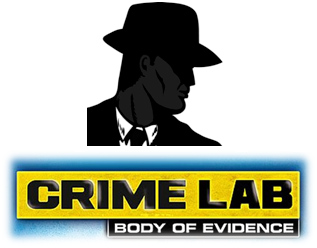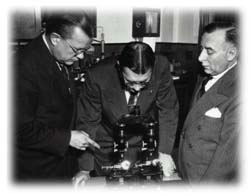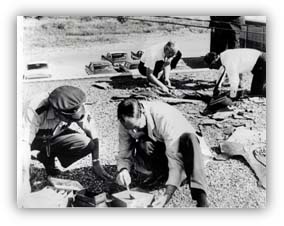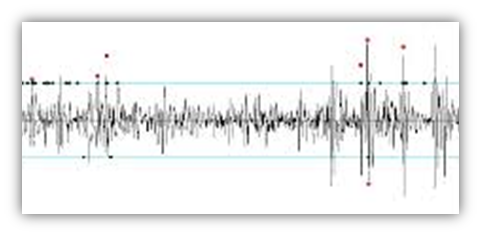The Saint Paul Police Crime Lab:
An Evolution In Forensics
by
Edward J. "Ed" Steenberg
Saint Paul Police Historical Society
Part IV: The Crime Lab

By the 1930s, Saint Paul had attracted national attention. J. Edgar Hoover and his new Federal Bureau of Investigation (F.B.I.) kept an eye on the city. Between 1931 and 1935, gangsters such as the Barker-Karpis gang, John Dillinger, Baby Face Nelson, Bugs Moran, Machine Gun Kelly and Homer Van Meter were among those who sought refuge in Saint Paul, openly flaunting their presence, while terrorizing other communities. Soon Saint Paulites became victims. In 1933, the Barker-Karpis gang kidnapped William A. Hamm Jr., the president of Theodore Hamm's Brewery in Saint Paul. The following year, they kidnapped Edward G. Bremer Jr., president of Saint Paul's Commercial State Bank and heir to the Schmidt Brewery fortune. Then, John H. Dillinger machine-gunned his way out of an apartment near Lexington and Grand, escaping from federal agents and a Saint Paul police detective. Homer V. Van Meter was not so lucky. Federal agents and Saint Paul police killed him in an alley near University and Marion streets.
Repeatedly, headlines in the Saint Paul Daily News demanded a cleanup of the city and the Police Department. The newspaper fired accusations at the Police Department, charging it with corruption, which included accepting bribes and gangsters tip-offs. Finally, the Daily News, with the approval of the Saint Paul Public Safety Commissioner, hired an outside investigator 28, who wiretapped Police Department telephones. In 1935, after months of inquiry, the investigation concluded. Thirteen members of the Police Department were suspended or fired for corrupt activities. Police Chief Michael J. Culligan 29 was forced to resign, but interestingly, none of the individuals faced criminal prosecution.
Although the newspaper's accusations proved to be true, the number of corrupt officers was few, compared to the 315 members of the Police Department. The following year, the City of Saint Paul passed a charter amendment, which changed the method for selecting a chief of police, thus eliminating the political favoritism of former years.
Under a new administration, the Saint Paul Police Department began to rebuild its image. In 1935, the Crime Laboratory was created, just three years after the Federal Bureau of Investigation established and organized their own laboratory. For years Saint Paul, like all other police departments, had relied on fingerprints and the Bertillon System to identify criminals. These proven identification systems were not abandoned. Instead, the new lab augmented investigations using up-to-date techniques and equipment. Under the direction of Dr. John B. Dalton 30, the new lab could do chemical analyses, document and firearms examinations, handwriting comparisons and photographic work, as well as fingerprint examinations. Among the new equipment were infrared and ultraviolet lights. Saint Paul offered the use of its lab, the first in the state, to surrounding police agencies, including the Minneapolis Police Department and the Minnesota Bureau of Criminal Apprehension (B.C.A.). Acting as a regional laboratory, it wasn't until January 01, 1947 that the B.C.A. Forensic Science Laboratory became operational on state-wide basis. On August 1, 1979 the Saint Paul Police Crime Lab began charging outside agencies for laboratory services.


Photo Left: Dr. John B. Dalton giving subject a polygraph test, along with
Policewoman Graciela M. Flores; April 3, 1957
Photo Right: Dr. John B. Dalton (left) demonstrates a new comparison microscope
to Public Safety Commissioner Robert F. Peterson and
Chief of Police Charles J. Tierney; January 17, 1950
The Crime Laboratory, as a functioning unit of the department, was formed on October 25, 1935 with the hiring of the aforementioned Doc Dalton, who studied under Chief August "Gus" Vollmer 31 while at the University of California, Berkeley. Provided space in the new Public Safety Building on Tenth and Minnesota Streets, Dalton started collecting the equipment and staff necessary to fulfill the function of a modern (1935) crime lab. In some cases items such as a cyanoacrylate fingerprint fuming cabinet/table were designed and built on-site. That process continued under his tutelage for the next twenty-five years.

Uxoricide 32 by Surrogate
SPPD Circa 1963

Photo Left: Carol Thompson was insured for over $1 million; Circa 1963
Photo Right: T. Eugene Thompson, Esq., murder mastermind; Circa 1963
At about 9:00 o'clock on the morning of March 6, 1963, in the quiet Saint Paul neighborhood of Highland Park, Carol Swoboda Thompson was bludgeoned with a rubber hose and a Luger pistol, and then stabbed multiple times with a kitchen knife by an intruder. She died from her injuries. Criminalists linked crime scene evidence, including the broken pieces of the handgun grip, to a primary suspect and soon thereafter three parties were arrested, prosecuted and convicted of the murder. One of the suspects was Carol's own husband, T. Eugene Thompson, a prominent Saint Paul criminal attorney. But as in the previously outlined criminal cases, the successful prosecution of this murder case hinged on a combination of good, sound investigative work on the part of the detectives, and the resolve of the forensic scientists to preserve, and analyze scientific evidence during the course of the investigation.

Criminal Code Offences
Types of Criminal Code Offences
Circa 1963
Of special interest in this case was the fact that T. Eugene Thompson, Esq., was a well known member in the legal community and was, in fact, a member of a committee formed by the Minnesota State Legislature to update the Minnesota Criminal Code 33.
Minnesota Automated Fingerprint Identification Network (M.A.F.I.N.), set up by the Saint Paul Police Crime Laboratory along with that of the Minnesota Bureau of Criminal Apprehension (B.C.A.) and the Minneapolis Police Department, became fully operational on February 12, 1979, the first in the nation to join forces in the creation of an automated fingerprint identification network. This network enabled fingerprint examiners to enter fingerprints from crime scenes into a database containing fingerprints of all arrested persons in Minnesota, including juveniles from Minneapolis and Saint Paul. A positive search resulted in a 'hit', indicating that the suspect had been identified through fingerprint records previously on file. The files soon expanded to cover neighboring states as well.
As a result of being the first state to have the computerized ten-print and latent identification system up and running, many visitors from across the nation and worldwide came to Saint Paul to study the network. Originally built by Rockwell International, the system development was later sold to De La Rule Pintrak of England. As more and more worldwide agencies developed their own networks an International Users Group was formed, and Saint Paul's Sergeant Joseph K. Corcoran 34 served with that group for several years. It was the wish of the users group that someday a single fingerprint taken of an individual in a squad car, on a hand held reader, could be identified not only by searching local files, but bounced off a satellite and searched through other system as well. Today that technology allows your fingerprints to be searched by many of those networks and allows for secure computer logins, as well as to start your smart phones, open your car doors, and provide for numerous other high-security related uses.

Lieutenant Hanggi (seated) and Sergeant Corcoran
at the new M.A.F.I.N. Workstation
SPPD Circa 1979
In the winter of 1971-1972 Detective Gerald A. Hanggi 35 and Sergeant Corcoran conducted a research project that involved putting fingerprints on items and then placing them outside, in Minnesota's inclement weather, leaving them there for several weeks. They then recovered the items and processed them for fingerprints. They were able to "lift" prints clear enough for classification.
At that time in the world of fingerprints, it was felt that if you went to a crime scene and found items the suspect may have touched such as shards of glass, and they were lying on the ground where it had rained or snowed over them, it was understood that the fingerprints would disappear and it wasn't fruitful to recover those items of evidence.
Lieutenant Hanggi's research was able to prove that theory wrong. Gerry wrote a research paper on their findings and presented it at the 1972 annual conference of the International Association of Identification (I.A.I.) in Milwaukee, Wisconsin. It was well received and changed the way police evidence technicians handled crime scenes and evidence left by suspects. Same findings were also delivered at an international forensic conference in Scotland by Lieutenant Jerome P. Dolan 36, with kudos going to both Hanggi and Corcoran.
In those days, every patrolman in the department was trained as evidence technicians, and in particular, the processing for fingerprints. Every officer had his own fingerprint kit, which he carried to crime scene investigations.

Jerry Dolan Dusting for Prints
SPPD Circa 1967
And then in 1988 the Saint Paul Police Department led the way in fingerprint technology when the department received a novel "inkless" fingerprint system designed by Digital Biometrics, a Minneapolis firm, which used sophisticated cameras to capture the prints' image. A printer then created a hard copy of the fingerprint. Only one other metropolitan agency had this technology at the time. Oh have we changed!
After the death of Dalton in 1960, the lab manager 'slot' was filled by Theodore R. Elzerman 37. Upon the resignation of Elzerman in 1967 the position went to Harold M. "Mike" Alfultis 38. Upon the resignation of Alfultis in 1973, Detective Gerald A. Hanggi assumed the position. After the retirement of Hanggi in 1990 several other sworn officers commanded the unit 39 for lesser periods of time (see "Timeline"), until the appointment of current Forensic Lab Manager Rosannna M.Caswell 40 in 2013. Caswell is backed up by a police sergeant and six police officers, two civilian forensic scientists, and a civilian lab assistant. A quality-assurance employee is part of the mix.
It should be noted that Doc Dalton was the first of a series of three civilian lab directors covering a span of some thirty-eight years, from 1935 to 1973. Detective Hanggi then started a series of at least six sworn officer directors covering the next forty years, from 1973 to 2013. A former criminalist reports that during that second phase, in about 1990-95, an attempt was made to have the crime lab nationally accredited, with negative results. Why? Although there were criminalists on staff with the required academic credentials, the director of the lab was not a trained forensic scientist.

Forensic Voiceprint
SPPD Circa 1970
In the early morning hours of Friday, May 22, 1970 Saint Paul Patrolman James T. Sackett, Sr. 41 was fatally injured by gunfire from a sniper while responding to a fake emergency "OB" call on a Hague Street address near the intersection of Victoria Avenue. Two suspects were arrested thirty-five years later and subsequently charged and convicted of the murder. The high-powered rifle used in the killing was never recovered, and the arrests would probably not have taken place without the testimony of the female subject making the bogus call. Her identity was obtained in 1970 through voiceprints, the first such case working its way through the court process… all the way to the Minnesota State Supreme Court 42. This was the first state court to uphold voiceprints as evidence, and today voiceprints are part of the normal investigative process, nationwide.
All of the aforementioned crimes were solved, based on sound detective work in the field and the preservation and analysis of various forms of scientific evidence during the course of the investigations. Sherlock Holmes would have been proud.
Part V: The Forensic Services Unit >>>
28 Wallace Ness Jamie, the third in a dynasty of gangster fighters. His father was Alexander G. Jamie of Chicago's "Secret Six", who had tackled Alphonse G. "Al" Capone, and his uncle was Prohibition agent Eliot P. Ness, the famed head of the "Untouchables".
29 Michael J. Culligan was appointed Acting Chief of Police on October 11, 1934; was appointed Chief of Police on October 16, 1934; was suspended for 30 days on June 25, 1935; and resigned on July 3, 1935.
30 John B. "Doc" Dalton, B.S., M.A., Ph.D., University of California, was appointed Provisional Expert Criminologist on October 25, 1935; was appointed Permanent Expert Criminologist on January 22, 1936; and died in office on September 13, 1960.
31 August "Gus" Vollmer was a leading figure in the development of the field of criminal justice in the United States in the early 20th century. He was the first police chief of Berkeley, California, and later founded the School of Criminology at the University of California.
32 Ux-o-ri-cide (Latin): The Murder of one's wife.
33 Minnesota Criminal Code. An advisory committee was formed in 1955 by the Minnesota State Legislature to undertake the process of updating the State's criminal code. That revision was completed and passed by the legislature in 1963. As chair of the Minnesota State Bar Association's criminal law committee, T. Eugene Thompson was a member of that legislative advisory committee. Upon conviction of the murder of his wife, T. Eugene was removed from that group.
34 Joseph K. Corcoran was appointed Patrolman on March 2, 1964; was promoted to Sergeant on October 3, 1970; had a change in title to Commander on November 1, 1997; and retired on March 27, 1998.
35 Gerald A. Hanggi, Sr. was appointed Patrolman on July 6, 1948; was promoted to Detective on August 10, 1957; was promoted to Lieutenant on January 11, 1973; and retired on February 16, 1990.
36 Jerome P. Dolan was appointed Patrolman on April 24, 1961; resigned on June 30, 1961 to go on the U.S. Secret Service; returned to Saint Paul on March 30, 1964; was promoted to Sergeant on September 30, 1967; was promoted to Lieutenant on November 27, 1971; and died on August 10, 1993.
37 Theodore R. Elzerman was appointed Criminalist on March 16, 1961; had a Title Change to Criminalist III on January 13, 1963; and resigned on June 9, 1967.
38 Harold M. "Mike" Alfultis was appointed Criminalist I on May 16, 1963; was promoted to Criminalist II on January 13, 1964; was promoted to Criminalist III on June 10, 1967; and resigned on March 23, 1973.
39 Other more recent commanders of the Crime Lab included Lieutenant Russell R. Walker, Lieutenant John C. McCabe, Commander Michael R. Morehead, Commander Colleen M. Luna, and Sergeant Shay L. Shackle.
40 Rosanna M. Caswell, B.S. (Chemistry), Arizona State University, was appointed Forensic Lab Manager on April 22, 2013; and was named the "2015 Civilian Employee of the Year" on March 31, 2016. Ms. Caswell, who came to Saint Paul from West Virginia where she held a position as a Senior Latent Print Examiner, started her forensic science career in 1999 with the Arizona Department of Public Safety.
41 James T. Sackett Sr. was appointed Patrolman on September 3, 1968; and was killed in the line-of-duty on May 22, 1970.
42 State Ex Rel. Trimble v. Hedman; 192 N.W. 2d 432 (1971). Voiceprint (spectrogram) analysis was conducted by Detective Sergeant Ernest Nash, Michigan State Police Crime Laboratory, from samples provided by Policewoman Carolen Bailey, Saint Paul Police Department. The decision of the trial court denying a writ of habeas corpus was affirmed by the Minnesota State Supreme Court on November 26, 1971. Voiceprint identification admitted – Minnesota Court Rule 901.
